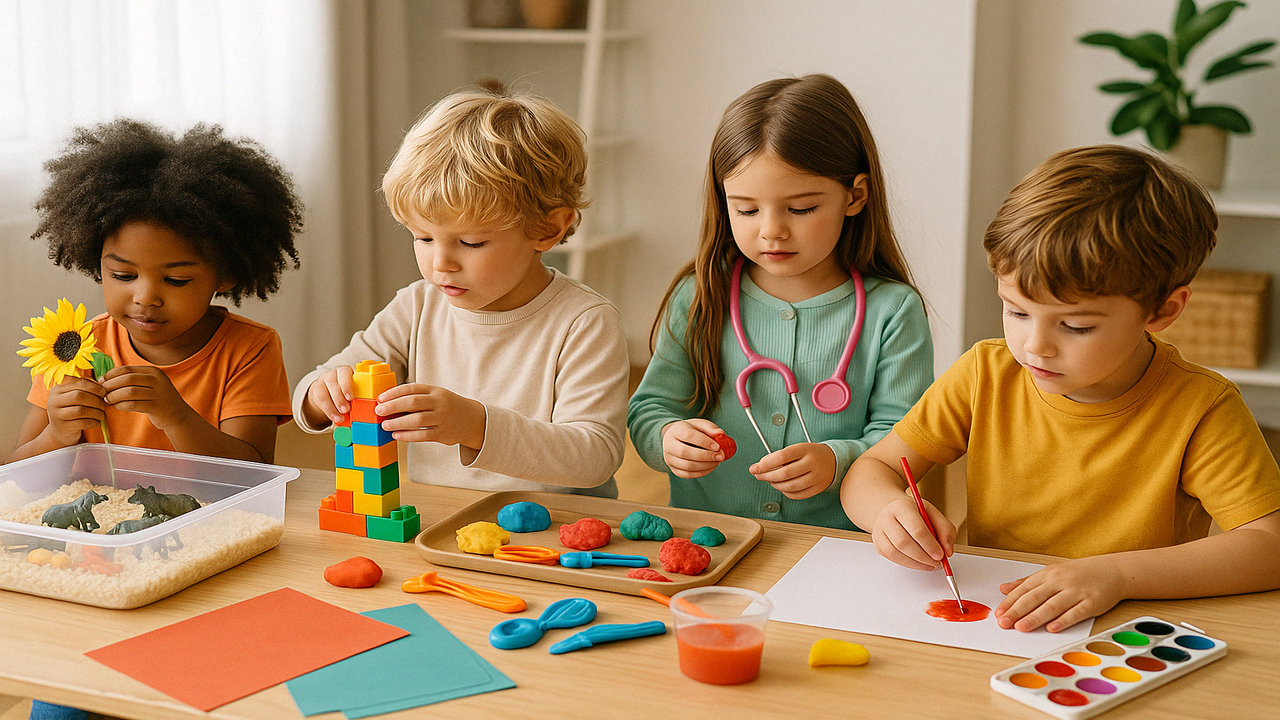
Best Creative Play Ideas to Train Children's Creativity and Sensory
Playsourcehome – Best Creative Play Ideas to Train Children’s Creativity and Sensory
Every child learns best through play. That’s why parents and educators are now focusing on the best creative play ideas that stimulate imagination and sensory development. These activities don’t just entertain — they build foundational skills that children carry into adulthood.
According to Playsourcehome and playsourceinfo.com, play is a powerful tool for learning. With the right approach, parents can encourage creativity, problem-solving, and cognitive development.
Creative play involves imagination, exploration, and hands-on activities. Unlike passive screen time, active play sharpens a child’s brain and senses. Children who engage in regular creative play often show better emotional control and communication skills.
Studies suggest that sensory play boosts fine motor skills. Children learn textures, patterns, and movement through simple activities like molding clay or playing with rice bins.
Sensory bins are among the most effective tools for early childhood development. You can fill them with rice, pasta, water beads, or sand. Add small toys or themed objects, and you’ve created an exciting discovery experience.
Encourage your child to describe what they feel. Are the items smooth, cold, squishy, or dry? These moments help develop vocabulary and critical thinking.
Playsourcehome notes that tactile learning strengthens memory and enhances focus during school years.
“Read more : Best Playgrounds in Barcelona: Fun Rides for Kids and Outdoor Play Adventures“
Let your children explore with glue, scissors, and colored paper. Creating collages or painting with natural items like leaves can enhance hand-eye coordination and inspire originality.
The best creative play ideas often come from ordinary supplies. You don’t need expensive kits — just imagination and a little space to get messy.
Keep a “creativity box” at home with safe art tools and recycled items. This gives kids free access to create whenever inspiration strikes.
Children love pretending to be doctors, astronauts, or chefs. Role-playing develops empathy and social skills. When they act out different characters, they learn to understand other perspectives.
Create a dress-up corner at home. Include hats, old clothes, and props. Encourage story-building through play.
Playsourceinfo.com highlights that role-play enhances communication, vocabulary, and leadership skills.
Take your kids outside for a creative boost. Nature offers endless inspiration — from collecting leaves to building fairy houses out of twigs.
Use natural materials to create seasonal crafts. Leaf rubbings, rock painting, or pinecone animals are fun and sensory-rich.
This type of outdoor play supports emotional regulation, physical coordination, and environmental awareness.
Building blocks are classic yet powerful tools. They teach children about balance, structure, and spatial reasoning. Adding other loose parts like bottle caps, buttons, or fabric pieces encourages innovation.
Allow kids to build freely without instructions. Let their imagination lead the process. This freedom builds confidence and resilience.
Water is one of the most versatile materials for play. Children enjoy pouring, splashing, and experimenting. Try adding sponges, funnels, or floating toys to the mix.
Water play can also introduce science concepts like volume, gravity, and density. Supervise closely and keep towels handy for the mess!
Playsourceinfo.com recommends water play for its calming effect and its role in fine motor development.
“Read more : 10 Long Tailed and Furry Animals that live in Natural Forests“
Music stimulates both sides of the brain. Playing simple instruments or dancing to music helps children develop rhythm, balance, and auditory skills.
Use homemade instruments like shakers or drums. Let children explore beats and sounds. Encourage them to create their own songs and movements.
This not only supports creativity but also improves coordination and memory.
Encourage children to tell their own stories. Provide puppets, dolls, or finger characters. Storytelling builds literacy and imagination.
Create a small puppet theater with a cardboard box. Invite your child to produce and perform their own shows.
According to Playsourcehome, this type of narrative play boosts verbal expression and emotional intelligence.
Involve your children in preparing simple snacks. Measuring, mixing, and decorating cookies can be a creative and educational activity.
Cooking teaches sequencing, counting, and fine motor control. Let kids decorate their food with healthy toppings to enhance creativity.
Always supervise, but give them a role in the kitchen. This builds independence and pride in their contributions.
Busy boards and wall panels are excellent for toddlers. They include buttons, zippers, latches, and textures to explore.
Mount a DIY busy board at home using old hardware and safe objects. It encourages curiosity, logic, and finger strength.
Such activities keep kids engaged and learning even in small indoor spaces.
Creative play flourishes when children feel safe to express themselves. Your role is to offer tools and encouragement.
The best creative play ideas offer more than entertainment. They develop essential life skills — from sensory awareness to social interaction. By incorporating ideas from sources like playsourceinfo.com and Playsourcehome, you can give your child a strong, joyful start in life.
Remember, creativity isn’t about perfection. It’s about expression, exploration, and growth.